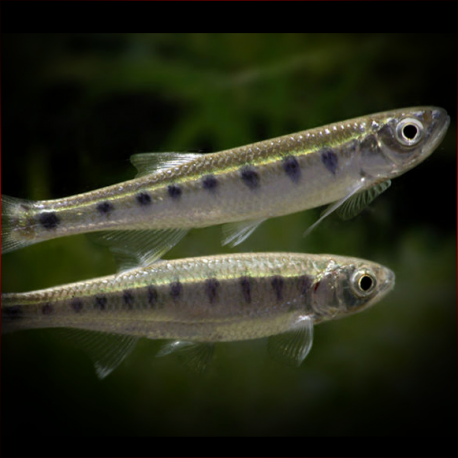More info
Datasheet
| Minimum Tank Size | 540 litres / 142.65 US gallons |
| Maximum Size | 12.5cm / 4.92inches |
| Temperature | 18°C / 64.40°F - 26°C / 78.80°F |
| Hardness | 2.02dgH / 36ppm - 12.05dgH / 215ppm |
| pH | 6.0-7.5 |
Behaviour
The Barilius vagra species is unsuitable for the general aquarium community due to its specific environmental requirements, as it tends to outcompete or intimidate slower and less bold species during feeding times. With its fast swimming speed and vigorous feeding habits, smaller fishes should be avoided as they may become prey. Ideal tankmates include similarly-sized, robust, pelagic cyprinids such as Dawkinsia, other Barilius, and larger Devario and Rasbora species. Bottom-dwelling companions like Garra, Crossocheilus, Botia, and Schistura are also suitable. While Barilius vagra is gregarious by nature, it prefers shoaling over schooling, developing a distinct pecking order within a group of five or more individuals to avoid bullying and aggression towards less dominant or solitary specimens.
Feeding and Diet
In their natural habitat, Barilius vagra predominantly feeds on aquatic and terrestrial insects, small fishes, and benthic invertebrates. In aquarium settings, it can be fed high-quality dried food supplemented with live and frozen options like chironomid larvae (bloodworms), Artemia, chopped earthworms, Drosophila fruit flies, and gut-loaded small crickets for optimal nutrition.
Reproduction & Dimorphism
Information about the reproduction of Barilius vagra is currently unreported, and sexual dimorphism is unconfirmed. However, it is suggested that sexually mature females may have a heavier body when gravid compared to males.
Habitat and Distribution
Barilius vagra is found in well-oxygenated, medium-to-high gradient rivers with moderate to fast-flowing water and substrates of gravel, cobbles, larger boulders, and exposed bedrock. Its habitat includes the Ganges and Brahmaputra river systems in northern India, Nepal, and Bangladesh, with potential occurrences in Afghanistan, Pakistan, and Sri Lanka. The species is commonly found in the East Rapti River in Nepal, alongside various other cohabiting species.
Aquarium Setup
For Barilius vagra to thrive in captivity, an aquarium setup resembling a flowing stream or river is recommended. The tank should have a substrate of rocks, sand, fine gravel, and water-worn boulders, with the addition of driftwood for decor. While most aquatic plants struggle in such conditions, hardy varieties like Microsorum, Bolbitis, or Anubias can be attached to the decor. The species requires spotless water with high oxygen levels and moderate water movement, necessitating the use of filters, powerheads, and airstones. Regular water changes and a secure cover are essential due to the species' jumping tendencies.

